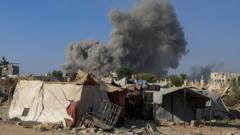The situation in Gaza City has escalated dramatically as Israeli forces intensify their bombardments in anticipation of a significant ground operation to take control of the besieged urban territory. Reports indicate that the continuous assault, described by local residents as relentless, has left the population—estimated at nearly a million—facing dire conditions.
In the past 24 hours alone, Israeli airstrikes and tank fire have led to the reported deaths of 64 individuals and injuries to nearly 300, according to the Hamas-run health ministry. The cumulative toll since the onset of Israel's military campaign against Hamas on October 7 has reached a staggering 62,686 fatalities, with approximately 157,951 wounded.
Israel's military operation, which was initiated as a direct response to a Hamas-led attack that resulted in significant casualties in southern Israel, has garnered international concern as Prime Minister Benjamin Netanyahu firmly commits to the obliteration of Hamas, despite growing calls for restraint.
With the mobilization of about 60,000 reservists to support the ongoing military efforts, Israeli air strikes have intensified, particularly in the Zeitoun and Shejayia neighborhoods. Troops have also resumed operations in the Jabalia refugee camp, reinforcing control in strategically significant areas, as stated by the Israel Defense Forces (IDF).
In a concerning humanitarian update, the World Health Organization (WHO) reported the release of a staff member held by Israeli forces in Gaza since July, although details surrounding the individual’s detention remain undisclosed.
Netanyahu faces mounting pressure domestically, particularly from families of hostages taken during the initial Hamas assaults who are advocating for negotiations to secure their release. Current estimates suggest that only 20 of the 50 hostages are still alive.
Previous indirect negotiations aimed at securing a ceasefire and facilitating hostage exchanges collapsed, prompting Israel to assert its intention to fully occupy Gaza Strip, which has led to a dire humanitarian narrative as Gaza City now faces what numerous agencies describe as a catastrophic humanitarian disaster.
As conditions in Gaza continue to deteriorate—with over 90% of homes either damaged or completely destroyed and a humanitarian crisis unfolding with reports of famine—Israeli officials have indicated plans for the evacuation of Gaza City’s residents to southern shelters prior to launching a full-scale ground invasion. The call for humanitarian aid amidst this unfolding crisis raises crucial questions about the future of Gaza and the prospects for peace in a region long beset by conflict and turmoil.
In the past 24 hours alone, Israeli airstrikes and tank fire have led to the reported deaths of 64 individuals and injuries to nearly 300, according to the Hamas-run health ministry. The cumulative toll since the onset of Israel's military campaign against Hamas on October 7 has reached a staggering 62,686 fatalities, with approximately 157,951 wounded.
Israel's military operation, which was initiated as a direct response to a Hamas-led attack that resulted in significant casualties in southern Israel, has garnered international concern as Prime Minister Benjamin Netanyahu firmly commits to the obliteration of Hamas, despite growing calls for restraint.
With the mobilization of about 60,000 reservists to support the ongoing military efforts, Israeli air strikes have intensified, particularly in the Zeitoun and Shejayia neighborhoods. Troops have also resumed operations in the Jabalia refugee camp, reinforcing control in strategically significant areas, as stated by the Israel Defense Forces (IDF).
In a concerning humanitarian update, the World Health Organization (WHO) reported the release of a staff member held by Israeli forces in Gaza since July, although details surrounding the individual’s detention remain undisclosed.
Netanyahu faces mounting pressure domestically, particularly from families of hostages taken during the initial Hamas assaults who are advocating for negotiations to secure their release. Current estimates suggest that only 20 of the 50 hostages are still alive.
Previous indirect negotiations aimed at securing a ceasefire and facilitating hostage exchanges collapsed, prompting Israel to assert its intention to fully occupy Gaza Strip, which has led to a dire humanitarian narrative as Gaza City now faces what numerous agencies describe as a catastrophic humanitarian disaster.
As conditions in Gaza continue to deteriorate—with over 90% of homes either damaged or completely destroyed and a humanitarian crisis unfolding with reports of famine—Israeli officials have indicated plans for the evacuation of Gaza City’s residents to southern shelters prior to launching a full-scale ground invasion. The call for humanitarian aid amidst this unfolding crisis raises crucial questions about the future of Gaza and the prospects for peace in a region long beset by conflict and turmoil.




















